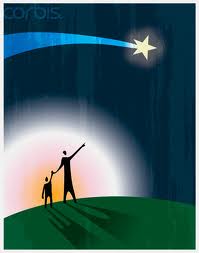by Angier Brock
When I was young, I used to see lots of shooting stars. One summer in particular stands out. My family was spending the month of July in the Vermont countryside, and my brother, some friends, and I spent hours lying in a field on blankets looking up at the night sky. As I recall, we saw shooting stars all over the place, dozens and dozens of them. In addition to that summer, I remember random other times when I looked up and glimpsed a meteorite streaking across the sky. What a glorious sight, and what a thrill!
Star-gazing depends, of course, on being able to get away from city lights. It also depends on finding the heavens free of both moonlight and clouds. Last weekend, I was in the mountains of Virginia, far from city lights and with an unusually clear sky. The only problem was the waxing gibbous moon, which was bright enough to wipe out many of the stars in its path. Not to be deprived of a possible star watching opportunity, my almost ten-year-old granddaughter consulted an astronomy chart and determined that the moon would set behind Yellow Spring Mountain about 1:30 a.m. All we had to do was set an alarm clock for The Middle of The Night, when the sky would be dark, and get up to see what we could see.
What we saw first was the Milky Way, vast and sprawling above our heads. Over the next quarter of an hour or so, we also picked out the Big Dipper, Cassiopeia, the Pleiades, and Cygnus the Swan. We think it was the tail of Draco the Dragon we saw plunging behind North Mountain, and as we turned again to the East, a very bright Jupiter was rising.
And then it happened. Just as I was thinking it was time to go back to bed, one lone meteorite blazed overhead in a long and beautiful streak. It was the only shooting star we saw—but it was a beauty, one made all the more glorious for being the first one my granddaughter had seen.
It turns out to have been part of the Delta Aquarid shower, which is, like most meteor showers, an annual event. Probably the shooting stars I saw in Vermont in July of 1964 were also Delta Aquarids. Other such showers—some smaller, some larger and much showier—also occur regularly and predictably. There are, for instance, the Lyrids in April, the Orionids in October, the Geminids in December.
In fact, there are shooting stars every night, whether the moon is bright or not, whether the sky is clear or not, whether or not I’m awake and paying attention. That summer in July, I was lucky: I had time and opportunity on many nights to lie in a dark field and watch the heavens. Last weekend, I was lucky again, that time to be with a granddaughter who wanted to get up in The Middle of the Night to look for beauty in a dark sky.
But the point is, shooting stars are there every night—even though, like many of life’s good graces, they are often obscured by other things and so mostly go unseen. May they always be there, for each of us, at any age, whether we are looking for them or not. And may they remind us of all the surprising beauty that can happen in the dark, whether we see it or not.










